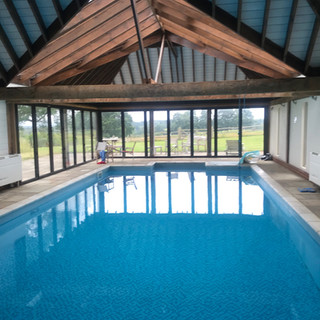Sussex Beef Burgers and Lamb at Jacob’s Ladder Farm
- Chris and Leah

- Oct 1, 2019
- 11 min read
Updated: Oct 8, 2023

It was a hot summer in Austria. Moving to the UK was welcome relief, with constantly changing days rotating from sun to clouds to rain. Just the sort of place that grows fantastic pasture grasses and clovers. Animal agriculture has been a part of the history of the British Isles for thousands of years. The local breeds of cattle and sheep have been bred for the conditions of specific locations and can still be seen grazing the same hills, dales, downs, and braes their ancestors did thousands of years ago dating back to 1066 or earlier.
The Farm
Jacob’s Ladder is the business belonging to Jayne and Michael, our generous hosts in Sussex. The farm is well located between London (30mi.) and Brighton (15mi.) with easy access to markets and millions of potential customers. They rent the 100-acre plot known as ‘Colin Godman’s Farm’ including a converted barn where they live with their two teenage daughters. Colin Godman was the first known owner of the property and operated it as a farm in the 1300s. The landowners-advocates for land preservation in the finite and expensive English real estate market-also live on the property in Colin Godman’s renovated 600 year-old cottage. They had originally converted the barn space into a holiday home for let until it became too difficult to manage (which is why it has an indoor pool that we got to enjoy as well), and thus decided to rent it to Michael and Jayne as farmland instead.


Between them, Jayne and Michael have experience in many facets of agriculture. Michael has had a cheese and yogurt business, raised many livestock species, and worked as a land agent in Wales and England. Jayne was previously a London cheesemonger for Neil’s Yard and consulted with farms on how to establish producer operated retail shops and market their products effectively. She also became a certified butcher in order to butcher their own animals. They both believe strongly in the need for change in agriculture and follow the regenerative philosophy of Allen Savory. In addition, they see meat production as an important part of maintaining perennial plant systems that provide food, sequester carbon, and improve soil.
On the farm they raise ‘Sussex’ cattle, a very old and locally adapted breed, as well as ‘Romney’ sheep. This sheep breed was selected for its disease resistance and the ease of lambing. Since Romneys usually throw only one lamb, the birthing usually requires no human assistance and is less stressful on the animals. These are important considerations for raising sheep as disease can be common and lambing can require lots of labor and nights spent sleeping in the pen with the animals monitoring for ewes going into labor.
The Pastures
The cattle herd has around 15 cows with calves depending on the year, while the sheep number as high as 60. Both are raised for meat only. The two livestock herds are both certified Organic and 100% grass-fed. They graze on the pastures from about April through October and eat hay produced on-site during the winter. The herds are managed separately. They keep a bull and rams, doing all their own breeding.
The animals are rotated through the many fenced fields according to Michael’s analysis of forage quality. On average, the herds are moved once or twice each week. During the winter, hay is fed daily from the large round bales produced all summer long. Due to the cool and wet climate, drying the hay seems to always be a challenge. Sometimes, cut hay would stay in the field and get rained on for a few days before there was enough sun to actually dry it out. Inevitably some of the hay ends up less than perfect. Michael prioritizes feeding poor hay first, and the worst of it gets used for bedding in the barn during winter. The old “Make hay when the sun shines” adage seems more true here than at any of the other farms so far.

These perennial pastures have been feeding livestock for centuries. In order to keep providing a complete diet for the livestock, close attention to pasture health is necessary. Michael makes regular use of a chain harrow to regenerate his pastures. The harrow basically roughs up the surface without getting too deep and damaging the root systems of the grasses and legumes already present. This action stimulates growth and makes for stronger plants. In addition, it scuffs up any blank areas in preparation for reseeding.
The pasture plants are allowed to reseed themselves on a rotating basis each year, depending on the grazing and hay making schedules. When Michael notices an imbalance of legumes vs. grasses (usually not enough legumes), he uses the chain harrow and then broadcasts new clover seed into those areas. The fields are not set up for irrigation and they depend on the rainy climate to do the watering. Thanks to the climate, the pastures are highly productive. We also spent some time clearing dock, a perennial weed, from an old pasture that Michael plans to use as straw bedding and hopefully hay in the future after some attention.
The Animals
All the animals are raised with great care, close attention to health, and the absolute minimum of medical intervention. Sheep are known to have parasite problems and be susceptible to many diseases. Most sheep producers preemptively give deworming treatments to the animals. However, Michael and Jayne prefer to develop a naturally resistant flock and only treat when they notice actual signs that the animal is suffering. They have selected the healthiest rams and ewes and estimate that less than 10% of the sheep require treatment. This greatly reduces the introduction of synthetic products into the sheep, making for safer and tastier meat. It also significantly reduces their costs in caring for the animals. The cattle have a similar situation, receiving no antibiotics and only vitamin boosters when health evaluation deems it necessary.

Overall, these animals live healthy and relatively stress-free lives. The only stressful event is being sorted and moved into a trailer to be driven to the abattoir for slaughter. Jayne says they would prefer to slaughter onsite, however no option for this currently exists in their area that would also allow them to retail market the meat.

The cattle and the sheep are both slaughtered throughout the year one cow or two sheep at a time. This maintains regular availability of product for their many markets and allows them to let other animals mature further at the same time. They begin taking lambs to the abattoir at six months old. They take 2-4 lambs per month year-round. This means that some of the lambs are more than a year old at slaughter. At this point they are called mutton.
The typical belief is that mutton is of lower quality and poorer taste than lamb. Jayne would like to challenge that idea. They have blind taste tested both meats side by side and had unanimous agreement that the mutton was superior. The added months of life allow fat to develop and muscles to be used, which comprises some tenderness, but increases flavor. Check out The River Cottage Meat Book by Hugh Fearnley-Whittingstall for a complete discussion of this point.

The cattle are slaughtered at 30 months. The United Kingdom requires slaughter at or before 30 months for retail sale. Waiting longer is possible, but significantly increases the cost of slaughter and the possible marketing options. This is an attempt by the government to reduce food safety issues that are believed to be a result of old age. If possible, Michael and Jayne would take some cattle as late as 3 years of age. In any case, even 30 months is far longer than most beef cattle live. Some industrial beef animals are slaughtered as early as a year, with the majority around 18 months.
Once again, the proof is in the flavor of the meat. The burgers we tried from these cows were deeply flavorful and delicious. We’ve had the good fortune to eat a lot of high-quality beef and this is at the top.
The Markets
Jacob’s Ladder Farm had the most diverse marketing of any of our farms so far. They market direct to customers through subscription boxes and bulk orders, wholesale lamb to an innovative mobile shop, sell through a busy local farm shop, and they cook and sell their burgers at festivals, events, and two farmer’s markets. In addition, Jayne also offers seasonal courses in butchery and sausage making and intends to expand this market sector beginning in spring of 2020.

The foundation for all of their meat marketing is the butchery. Jayne rents a building in a small industrial park full of other small-scale entrepreneurs including a candlemaker, ceramics studio, local ferments and pickles, etc. At the butchery she receives whole lambs and half cows in her walk-in cooler. From there the animals are butchered and processed into the variety of cuts and products on offer. As a part-time job, Jayne and one other person also provide butchering services to the meat department at Plaw Hatch, the farm shop that also sells some Jacob’s Ladder meat.
The subscription boxes are basically like a meat CSA, except less frequent. Customers order $100 worth of beef and/or lamb and receive it monthly or bimonthly. Pick-up usually happens at the farmer’s market, which saves them additional delivery expenses. The box contains a combination of cuts focusing on familiar ones like steaks and shoulder. The less popular cuts end up being sold through their burger business.
The ‘Organic Burgers’ appear weekly at one farmer’s market in London, monthly at another, and nearly every weekend during the summer at a variety of events. This is their primary way of interacting with public and advertising their subscription meat boxes, courses, and other products. It takes a lot of coordination to send out multiple operations every weekend. Jayne and Michael are limited to two events each weekend without having to hire additional labor, which isn’t currently in the budget for them.

Before the burgers ever make it to a market or event, they are produced in the butchery. We ground the beef, combining forequarter and hindquarter meat for a balanced fat content. Then we seasoned the meat, pressed the burgers, and vacuum packed them for storage. They’ll keep 3 weeks in the cooler, or much longer frozen if necessary. One steer can provide 1,800-2,000 burgers!
We got to see the burger process from its start at the butchery through to selling delicious burgers to customers at the ‘Saddles and Steam’ festival, an event honoring the history and development of transportation in the UK. It is located at a sort of living museum (think Colonial Williamsburg but less cheesy) with preserved period buildings dating as far back as the 11th Century. The burgers come medium, on a toasted bun with Montgomery Cheddar or Stichelton Blue cheese and arugula. They sell for around $9. Over the weekend, we grilled hundreds of burgers and talked to hundreds of people.

According to Jayne, the development of the burger business came out of the need to generate more money from each animal they produce. The alternative would be to sell more animals at wholesale prices, but the amount of land needed and the inevitable compromise in quality deterred them from this option. Selling mixed cuts of beef, including ground beef, they can get a price around $8 to $10 per pound. However, processing that same meat into ¼lb. burgers and selling them retail increases the gross income (after accounting for the cheese, bun, etc.) to about $30/lb. This allowed them to reach a position where they could profit enough from raising livestock on a small-scale to cover all their expenses as a family of four. While the overall profit isn’t huge, it allows them to continue doing something they love and feel strongly about, thanks to some creative marketing.
They have also had recent success selling lambs wholesale to a mobile shop in Brighton. The purchaser is able to sell as much lamb as they can provide and also buys beef. He sets up his mobile farm shop in residential neighborhoods of the coastal city. He focuses on areas that do not have a supermarket or at least not a supermarket that offers quality meat. The owner is a strong supporter of local meat producers and offers Michael and Jayne a wholesale price higher than they could get from other wholesalers. Since they also do not need to spend any time or money marketing any of this meat, it turns out be a worthwhile addition to the business for them.
Finally, their other major outlet is through Plaw Hatch, a busy farm shop selling local Organic products. They also have a coffeeshop on-site and the location has become a hub of local food activity. Plaw Hatch operates a dairy, vegetable farm, and also produces some meat. They are a community farm, founded by a group of investors interested in preserving rural land and culture. They provide farmers with opportunities without having to own land. There is a strong base of volunteers that also participate at the farm or in the shop in exchange for discounts. Michael and Jayne both farmed at Plaw Hatch before leaving to start their own business. Now, however, they market some of their meat through the on-farm shop, which can’t produce enough of their own meat to meet demand.
The Plaw Hatch Farm Shop is close to both Jacob’s Ladder Farm and the butchery site. This makes it an easy stop for Jayne to restock her meat products and pick-up groceries on the way home.
The Rest
England is pretty dumb and nobody likes it. In fact, it’s embarrassing to be from an English colony. Just joking. In all honesty, we loved our time in England. It was a comforting and familiar place to be after our far more foreign travel destinations. Thinking back to India, China, and Nepal…England sure felt like a cake walk and a place full of friendly people and jolly good fun (as they like say).
While we wished we had more time to explore the UK, we did get in a lot of walking on public paths winding and wandering throughout Sussex. After helping on the farm, we’d usually take Michael and Jayne’s dog, Rafi, for an afternoon walk along the nearby forest footpaths or to the lakes on the property. East Sussex is also where Winnie the Pooh is from and the road leading to the farm was actually a famous lane in Pooh's world. We had the chance to walk through The 100 Acre Wood and chatted about all the characters. Even better, there were several pubs within walking distance from the farm which allowed dogs!
Side note: we both learned the word origin and history of the traditional pub, which we both felt silly for never putting together. Pub is short for public house or public ale house, which was originally someone’s actual home that would sell drinks to the public. Over time, it just became a "pub". We also learned the distinction between a tied house vs. free house. A tied house is a public house required to purchase some of its beer offerings from a particular brewery or pub company, whereas a free house can choose the beers it serves freely without any contracts. We also learned, historically, a tavern was different from a public house in that they were run as a private enterprise, where drinkers were "guests" rather than members of the general public; sort of like a members only club.
We also took a day trip to the Southdowns, a hilly area of Southern England, and Lewes, a little historic city with loads of pretty lanes and old buildings to gawk at with our American eyes and say "Wow, so old.". Our hike along the Southdowns, which usually offers amazing views of the coast, was quite cloudy and one of the windiest walks of our lives. We all had a fun time though and got to see some different sheep wandering about too.
The last fun and odd thing we did was go to a Medieval Joust Festival where the main motivator was not the jousting on horseback, cannonballs flying, or intense battlefield reenactments but one of Chris' favorite bands was singing- the Mediaeval Baebes. It was a long time coming to actually see them live for him, and even cooler that it was at a celebration of all things Medieval.

Sadly we had to say goodbye to dear old England, so we decided to head to New England in order to continue feeling a bit like we were in England still. More to come from the flower farm in the Adirondacks.
















































































































Comments